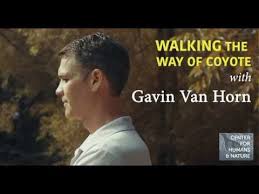
This is a book to ponder, to read and put down and go for a walk and test your own sense of place and powers of observation. What do you see out of the corner of your eye? Underfoot? In that tangle of vegetation, in that bit of wetland, along the tracks there? And what do you not see, what is missing that might be there, if only? What if you did this walk at dawn or dusk or in the darkness of night? This book will open your eyes to possibilities and probabilities: Coyote and his cohorts are likely out there.
Gavin Van Horn lives and writes in Chicago, a much bigger city than ours, a city that catapulted itself into national prominence through economic hegemony, craftiness, ruthlessness and luck. A good background read for this book on Chicago would be William Cronon’s classic, Nature’s Metropolis, but Gavin gives enough of the history and geography of the city and its habits of growth to ground you in where he wants to take you next. His goal is to show you the city as you might not have imagined it, as a home for wildlife as well as commerce, and to reveal how enriching and transformative it might be to embrace this already present “otherness.”
Gavin explores the city largely on foot, sometimes by kayak, mostly on the ground but also from high above, perched at the level where peregrine falcons hold sway. He hangs out in patches of scruffy left-alone places to find the native plants, voles, mink, beavers, birds, bats and other creatures who favor edge habitats, or who have survived being pushed to our edges, but he also finds plenty of life right in the urban center, mixing it up with cars and human city dwellers. He celebrates everything he discovers. Each encounter opens his mind further to “if this, why not that?” His questions and quests ripple and probe, thoughtfully, joyously, full of hope but not without the knowledge that it won’t be easy or quick to change how we humans live to give more room for everybody else.
Coyote—the mythological animal and the real four-legged sharp-toothed clever one that has slipped into our cities and suburbs all across the country—guides and prods Gavin in his explorations. His other seers are Lao Tzu, the legendary scribe of ancient Taoist thought, and Aldo Leopold, who described and lived by a land ethic that placed humans within the biological community of beings, not on top or outside of the web of life. Taking his cue from these giants, Gavin heads out to construct an urban land ethic. He talks and walks with others who also seek to find and, if needed, mend torn connections, or forge new ones, or discover and nurture new threads of belongingness. Many hands are quietly at this work; Gavin’s is a shared vision made all the brighter by the community of like-minds he finds all over the city. This book is full of examples, experiments, observations, things we could try here or also discover are underway and only need uncovering and a boost. We could follow in his footsteps.

As I read, I filled page after page with excerpts, gems to share, flashes of wisdom I wanted to carry with me. Though limited in my travels by the pandemic and then the smoke-filled air, my reading and thinking felt expansive and liberating. I wanted to launch a pollinator’s trail on my street or go down to see if the otters still played in Capitol Lake and was the fox we once witnessed trotting down my friend’s street with a whole barbequed chicken firmly in its grip still making a good living in her neighborhood? All these endeavors and questions will have to wait but the vision of how to live in a city with ecological integrity, with capaciousness and sensitivity to the needs of all beings who share the resources and spaces buoyed me up in this difficult time and made me eager to get involved in whatever way possible to build an urban land ethic here. I’ll leave you with just one nugget to encourage you to read this book and add to our community of rewilding stewards. Reminding us that wilderness is found everywhere and not just in pristine old-growth forests or mountaintops or other set-aside enclaves, Gavin, looking at his city, writes:
With no mountains to bend around, nothing but horizon except for the constantly expanding city skyline, the burgeoning metropolis must have seemed like a blank canvas for unimpeded ambition…There is a new story to tell about cities—one that can shift the plot from acquisition and exploitation to inhabitation….One in which the city becomes life affirming instead of life denying, a generator of biological complexity and diversity rather than simplicity and impoverishment. Such an understanding of cities requires a shift in perception. A summary of this shift in perception might be called an urban land ethic….land as a social relationship.
We have so much to learn; so much that can enliven our sense of where we are in the world. And with whom we can live, with whom we are already living.
For a more information about the organization that supports Gavin’s work, see: HumansandNature.org







